| |
IF THE JESUITS HAD SUCCEEDED IN CREATING A CATHOLIC SUPERPOWER IN AMERICA.
BRITANNIA WOULD HAVE BEEN BLOCKADED, AND A CATHOLIC "STUART"
PLACED ON THE THRONE ONCE AGAIN!!
|
|
By 1750, Britannia was running out of trees to construct ships. Many of the ships used for commerce and by the Royal Navy were constructed in Philadelphia—the shipbuilding capital of the colonies:
The local supply of ship-timber in the forests of England, particularly of frames, knees, keels, and the larger spars had begun to decline to the danger point by 1750. The size of ships, both for commerce and for war, were constantly increasing. This increase incessantly involved the use of longer and heaver timbers for frames, larger knees and futtocks, and thicker planking. Meantime the forests of England became smaller and smaller. The great oak trees had been cut down and sawed or hewn up, and the younger stems had not found time to grow in their stead (Buell, The Memoirs of Charles H. Cramp, pp. 16-17).
By contrast, the 13 colonies were covered by vast forests....The ship that brought Warren Hastings to India was built in Philadelphia. Hastings was sailing in the wrong direction at that time!
George
Augustus was born on June 4, 1738, in London. A man of peace throughout
his life, he became king when his grandfather, George II, died suddenly
during the momentous Seven Years' War between Britannia Inc., and France.
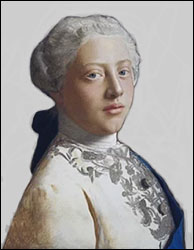 George
as Prince of Wales.
George
as Prince of Wales.
|
| |
Hanoverian George III was king during the most momentous
times in the history of the world.
His
reign encompassed the American and French Revolutions
and the birth of the New Jerusalem.
George
was called "Mad King George" by Gog and Magog, but that was because
he was a devout Christian who read the Bible and
prayed
twice a day.
What a contrast between Generalissimo George and the real Saint George!
|
|
|
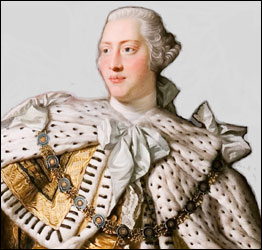
King George III (1738–1820).
Reigned from 1760 to 1811.
|
When the future King George III was only 7-years-old, the "Young Pretender" named "Bonnie" Prince Charlie landed in Scotland with the goal of restoring the Catholic Stuart monarchy. The "Young Pretender" was welcomed by the fiery Flora MacDonald, whose descendants would later found the McDonald's fast food chain.
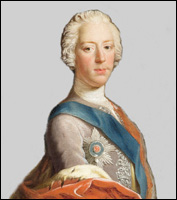
The young "New Pretender"
(1720–1788). |
| |
In 1745, the "New Pretender" landed in Scotland with the express goal of marching on London and deposing King George II.
As his army of wild Highlanders marched south, opposition grew because the people still remembered the warming pan plot!
Just 125 miles from the capital he lost his nerve completely and turned back! |
|
|
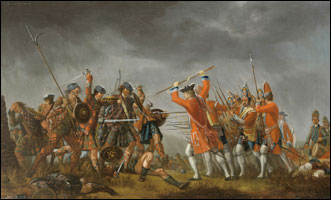
The Battle of Culloden was fought
on April 16, 1746. |
Two of the men closest to George Washington fought for the "New Pretender" at the Battle of Culloden in Scotland. After the battle, Mercer fled to British North America, to continue the war against the Protestant Christian House of Hanover.
After the French and Indian War, he moved to Fredericksburg, and became the personal physician to George Washington. He failed to cure George of syphilis and make him heir conditioned once again!
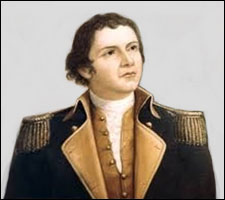
"Fighting Physician" Hugh Mercer
(1726–1777). |
| |
"Fighting Doctor" Hugh Mercer was the personal physician to George Washington but he failed to cure him of syphilis.
A rabid Jacobite, he refused to surrender, and he died from bayonet wounds after the Battle of Princeton in 1777.
John Murray, 4th Earl of Dunmore, was the governor of Virginia in 1776. He had to make a pretense of fighting the "rebels," like Winston Churchill made a pretense of fighting his cousin Adolf Hitler. |
|
|
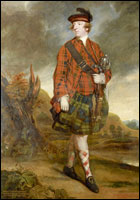
John Murray, 4th Earl of Dunmore
(1730–1809).
|
John Murray was a rabid Jacobite. In 1793, his daughter, Lady Augusta Murray, was secretly married to Prince Augustus Frederick, 6h son of King George III. That marriage took place in Roma, and contravened the Royal Marriages Act of 1772 because the Prince had not asked his father's permission, and so she was not recognized as his wife.
Immediately
after the coronation of King George he was ordered to wed. There were
plenty of eligible young ladies in Britain but the Privy council sent
a delegation to the tiny German Duchy of Mecklenburg-Strelitz for
a bride. Her name was Charlotte.
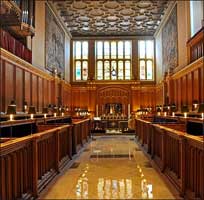 The Chapel
Royal at St. James's
The Chapel
Royal at St. James's
Palace where the wedding took place |
| |
The
young king married Charlotte of Mecklenburg-Strelitz on
September 9, 1761.
The
couple had 15 children, with 13 surviving.
The
noble Christian king abhorred what he called
"petticoats in politics," so he kept a tight
rein on his wife to keep her out of the sinister
palace intrigues. |
|
|
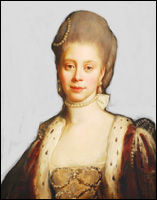
Queen Charlotte (1744–1818).
Queen from 1761 to 1818. |
Nevertheless,
the conspiracy was strong, and like Maacah, she mothered
the monster who became the regicidal Prince of Wales.
The
king is blamed for "losing" the American colonies by compelling
them to rebel against unfair taxation. As a devout Christian, the
king never intended to compel anybody, and he was very sympathetic
with the Methodists and peace-loving Quakers. Even if he wanted too,
the king had absolutely no power to compel anybody because Parliament
stripped the monarchy of all its finances with the Civil List Act
of 1694:
He
was well aware that theoretically nothing in either the Bill of Rights
of 1689 or the 1701 Act of Settlement stood in the way of his declaring
war, nominating peers, appointing bishops and ambassadors as well
as judges and army and naval officers, and summoning or dissolving
Parliament. But in practice he was constrained from doing so, since
the Civil List Act of 1698 was intended to give the monarchy finances
enough only for the Court and the civil service. It was Parliament
which voted money each year for the Army and Navy and for servicing
the national debt. The King therefore needed Parliament's approval
of his government, and he soon came to realise that his undoubted
power of appointing Ministers was qualified by the necessity of gaining
parliamentary support for their measures. (Hibbert, George III,
pp. 76-77).
Additionally,
the crown's revenue was further reduced by Edmund Burke in 1782:
Legislation
designed to reduce the influence of the Crown went through Parliament
with little opposition. The King feared that the ministers would seize
the opportunity to impose Treasury control over the Privy Purse, but
this seems never to have been their intention. There were in effect
three measures: the disfranchisement of officers of the customs and
excise; an Act to incapacitate government contractors from sitting
in the House of Commons; and Burke's Civil List Act, designed to reduce
government expenditure and prevent the Civil List from running into
debt. The King accepted all three measures, and suggested a number
of improvements to Burke's Act. (Brooke, King George III,
p. 229).
King
George did not have any money to compel the colonies or finance any
Revolution. His growing family, which eventually numbered 13 surviving
children, had barely enough money to meet their daily expenses.
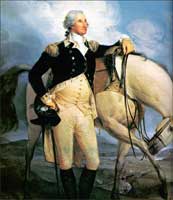
George
Washington in full
military regalia.
|
|
King
George's income was drastically reduced by the Civil
List Act.
Financing
for the American Revolution came from the British Parliament.
Gold from India and Hudson's
Bay Company beaver pelts paid for the Revolution
. . . and the Prussian mercenaries opposing
it. |
|
|
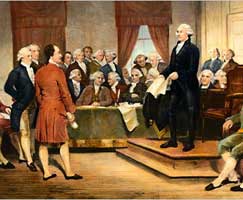
The Founding Fathers in
Philadelphia, July 4, 1776. |
George
Washington couldn't be a "Founding Father" because he was
sterile. His wife Martha received a usury check every month from the
Bank of England, and George's Mount Vernon Mansion was never shelled
by the British. Before he joined the Revolution, George was an officer
in the British colonial army. Additionally, George owned hundreds
of slaves.
According
to Thomas Jefferson's Declaration of Independence, King George
was Satan incarnate:
The
history of the present King of Great Britain is a history of repeated
injuries and usurpations, all having in direct object the establishment
of an absolute Tyranny over these States. To prove this, let Facts
be submitted to a candid world.(Declaration
of Independence).
Jefferson
goes on to enumerate a long list of "abuses" which King
George had nothing to do with whatsoever. The king spent more time
on his knees praying each day than Jefferson did in his entire lifetime.
King George received
the first U.S. ambassador graciously!!
After
the creation of the United States, John Adams was appointed the first
ambassador to the Court of St. James. The king received him graciously,
with no recriminations, or desire for revenge for losing the best
real estate in the world.
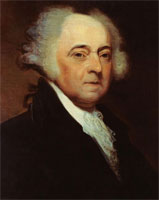
John Adams (1735–1826).
Ambassador
from '85 to '88.
|
| |
King
George received the new ambassador from the United States
on June 1, 1785.
John
Adams was given a cordial reception by the king, who was
willing to forget the past and forge a genuine
friendship with the new nation.
Unlike
the Papal Parliament, the Christian king was not plotting
the speedy demise of the New Jerusalem. |
|
|
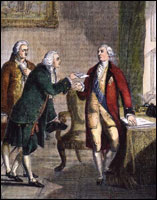
John Adams presenting his credentials to the king. |
John
Adams described the meeting in one of his letters:
The
circumstances of this audience are so extraordinary, the language
you have now held is so extremely proper, and the feelings you have
discovered so justly adapted to the occasion, that I must say that
I not only receive with pleasure the assurance of the friendly dispositions
of the United States, but that I am very glad that the choice has
fallen upon you to be their minister. I wish you, sir, to believe,
and that it be understood in America, that I have done nothing in
the late contest but what I thought myself indispensably bound to
do by the duty which I owed to my people. I will be very frank with
you, I was the last to consent to separation; but the separation having
been made, and having become inevitable, I have always said, as I
say now, that I would be the first to meet the friendship of the United
States as an independent power. (McCullough, John Adams,
p. 336).
To
the members of the Papal Parliament, the new United States was only
temporary, until New Orleans was conquered, and Louisiana became a
British Crown Colony.
The
Prince of Wales' top secret marriage to Maria Fitzherbert in 1785
In
1785, George Augustus, the eldest son of the king contracted a top
secret marriage with Papal Maria Fitzherbert. That marriage violated
2 Acts of Parliament: the Act of Succession of 1701, and the Royal
Marriage Act of 1772.

George, Prince of Wales
(1762–1830). |
| |
In
December 1785, the Prince of Wales was secretly married
to Papal Maria Fitzherbert.
The
couple were the grandparents of Queen
Victoria.
The
marriage violated 2 Acts of Parliament.
The
illegal marriage was first performed by a Jesuit priest
and then later by a bribed Anglican clergyman. |
|
|
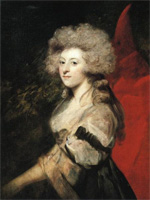
Maria Fitzherbert
(1767–1837). |
Femme
fatale Maria was a widow who had already
buried 2 husbands. Everything
had to be done clandestinely but the Prince of Wales assured Maria
that he would repeal the Royal Marriage Act as soon as he became king:
It
will be helpful to mention here three statements made by the Prince
to Knight which help us to understand Maria's surrender and the
Prince's understanding of the crisis he was provoking. Knight later
told Sir William Fraser: 'You have no idea what were his powers
of persuasion: he could when he chose be the most delightful of
men; indeed irresistible.' Secondly, the Prince
told Knight that he would 'repeal the Royal Marriage Act the instant
he came to the Throne.' (Munson,
Maria Fitzherbert, p. 144).
George
did not expect to wait very long for that to happen.
The
first attempt to murder the king happened in 1788
It
was amazing how different father and son were. It almost seemed that
the son had completely different parents.
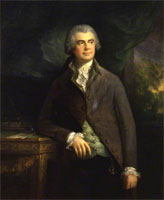 Dr. Richard
Warren
Dr. Richard
Warren
(1731–1797).
|
| |
The
Prince of Wales ordered "physicians" Richard
Warren and Sir George Baker to expedite his
way to the throne.
The
"doctors" poisoned the king, but our great
JEHOVAH preserved his life, because he was a great king
and a praying Christian.
When
he refused to die, the "physicians" said that
he had "gone mad."
|
|
|
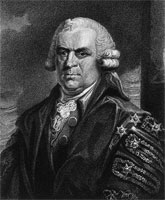
Sir George Baker
(1722–1809).
|
Their
poison having failed to kill the king, the physicians said that the
king was mad and incapable of performing his royal duties. Parliament's
answer was that the Prince of Wales should be appointed Regent:
By
November it seemed likely that the twenty-eight-year reign of George
III was coming to an end and that the Prince would become Regent.
As such he would exercise royal power to construct governments, appoint
and dismiss ministers, create peers and distribute patronage. It was
assumed that within hours of taking over the Prince would dismiss
Pitt and put the Opposition into power. The three great goals of eighteenth-century
politics –the disposing of peerages, places and pensions–would
be his at last. As for Maria, who could say what would happen to her?
(Munson,
Maria Fitzherbert, p. 213).
On the morning
of November 29, 1788, the king was forcibly removed from Windsor Castle
to the White House at Kew.
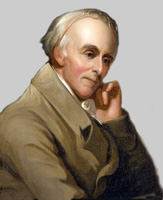
"Dr."
Benjamin Rush
(1745–1813).
|
| |
The
king was removed from his family and placed in a torture
chair developed by "Dr." Benjamin Rush
of Philadelphia.
During
a "yellow fever" epidemic" in Philadelphia
in 1793, Rush killed so many people by bleeding them
that he earned the sobriquet "Dr. Vampire."
So
many people died that George Washington declared the city
unsafe and told the government to pack up and
move to the new city called by his name!!
|
|
|
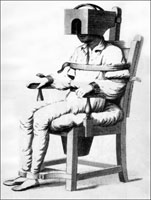 "Dr."
Benjamin Rush's
"Dr."
Benjamin Rush's
torture chair. |
The
king was confined in a torture chair right out of a Spanish Inquisition
dungeon. The chair was designed by American Revolution "patriot"
"Dr." Benjamin Rush. In the most unkindest cut of all, medicine
man Rush called his torture chair a "Tranquilizing Chair:"
He
was also confined in a specially made chair–his 'coronation
chair' he called it–to ensure his 'compliance with whatever
[was] thought proper'. And once, when he was tied in the chair to
be given a severe lecture on his improper and repetitive remarks about
Lady Pembroke, a handkerchief was stuffed in his mouth to keep him
quiet until the reprimand was completed.
(Hibbert, George III, p. 277).
Patriotic
Britons who wrote about the illegal marriage of the Prince of Wales
to Maria Fitzherbert were imprisoned for libel, and many of them never
survived their brutal captivity.
Despite
all the efforts of the "doctors" to kill the king or drive
him mad, they were abject failures. The king gradually recovered, and
by March 1789, he was ready to resume his kingly duties:
On
14 March the King returned to his favourite residence, and at every
village on the road crowds turned out to cheer him. He rode on horseback,
and the warmth of his reception when he arrived quite overwhelmed
him. 'All Windsor came out to meet the King', wrote Fanny Burney,
and even the soldiers on guard at the Castle were in tears. He had
a much quieter night, he wrote the next morning, than any he had experienced
since his illness; 'and the joy that appears in every countenance
and the good sense of my neighbours in not wishing to incommode cannot
fail of having a due effect'. (Brooke, King George III, p.
342).
That
Papal plot had been forestalled . . . for now....Only 4 years later,
another watershed event occurred called the French Revolution.
Louis
Philippe Joseph was
the Absalom of France
The
next earth shaking event to occur after the American Revolution was
the French Revolution. The long reigning Louis XVI was king and Maria
Antoinette was his queen. Financing for both Revolutions came from the
British Parliament.
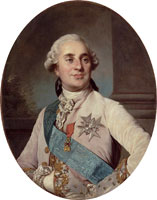
King Louis XVI (1754–1793).
King from 1774 to 1792. |
| |
The
official beginning of the French
Revolution was the storming of the Bastille on July
14, 1793.
The
éminence grise behind the storming of the Bastille was Louis
Philippe Joseph, Duc d'Orleans.
The
duke was the cousin of King Louis XVI and he shared a mistress
(Grace Dalrymple Elliott)
with
the Prince of Wales. |
|
|
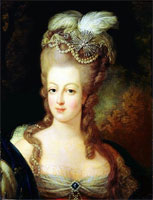
Queen Maria Antoinette
(1755–1793).
Queen from '74 to '92. |
Prior
to the French Revolution, France had experienced some disastrous grain
harvests, but grain speculator Louis Philippe Joseph exasperated the
situation by shipping grain to Britain:
On
July 13 1788, France had experienced the most violent and sustained
hailstorm in its history which devastated the most fertile land and
ruined the harvest. There were persistent rumours at the time, related
in great detail by the historian Montjoie, that the Duc d'Orléans
had taken full advantage of this natural calamity to acquire the remaining
grain and ship it to England. This had been made possible under the
calamitous free-trade agreement signed a year earlier by the Finance
Minister, de Brienne. The plan appears to have been devised by Laclos
and to have been executed by the Marquis Ducrest. The intention was
to hold the grain in England until famine forced the King to abdicate
and then ship it back to a grateful France. This was certainly a dangerous
and callous scheme to inflict on starving people and reflects Laclos'
ruthless approach to politics. It is hard to understand why Louis
Philippe Joseph, with his sincere and well-established reputation
for charity and concern for the poor, agreed to it. (Ambrose, Godfather
of the Revolution, p.137).
Louis
Philippe Joseph, Duc d'Orleans, was the driving force behind the French
Revolution. He was also a very close friend of the Prince of Wales.
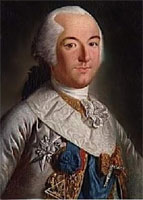
Louis Philippe
Joseph
(1747–1793).
|
| |
Louis
Philippe Joseph, "Philippe Égalité,"
was the driving force behind the French Revolution and
the execution of his cousin, King Louis XVI.
In
1752, Louis inherited the title Duke of Chartres, and
in 1769 he married Louise Marie Adélaïde de Bourbon, the
richest heiress in France.
In
1784, Louis visited London and became very good friends
with the Prince of Wales.
|
|
|
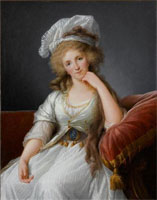
Louis Maria Adélaïde
(1753–1821). |
Louis
first met the Prince of Wales in 1783 but King George was present and
they could not discuss their plans for the upcoming French Revolution:
When
he returned to England the following year Chartres found that his
relationship with the Prince of Wales was much improved and verging
on a warm friendship. Now they began going about together, visiting
the races and theatres in the company of the prettiest actresses.
Invited to join George in July at his pleasure dome, the Brighton
Pavilion, Louis Philippe Joseph stayed on until late August. Later
he wrote his host: 'Nothing has given me greater pleasure than your
assurances of friendship. Please count me as one of your best and
most devoted admirers.' Returning to London, he insisted on attending
another parliamentary debate, this time the House of Commons, a democratic
institution that did not exist in France. By chance the debate included
a powerful speech by Pitt the Younger attacking the power of the crown
and blaming it for the growing corruption and infringement of civil
liberties that were against the interests of the British people. (Ambrose,
Godfather of the Revolution, pp. 95-96).
The French Revolution
was financed by the British Parliament and the vast fortune of Louis
Maria Adélaïde. France was just saturated with Papal British spies at
that time.
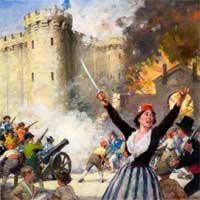
Storming of the Bastille,
July 14, 1789.
|
| |
The
Revolution was directed by Philippe Égalité
from his HQ at the Palais-Royal.
On
January 15, 1793. Louis cast his vote to execute King
Louis XVI–his
own cousin.
Louis
could have replaced the king on his throne but that position
was reserved for British Secret Service agent Napoleon
Bonaparte.
|
|
|
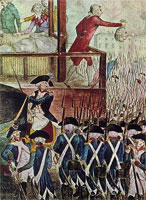
The beheading of King
Louis XVI, Jan. 21, 1793. |
When
the Reign of Terror began, Louis was urged to join the Prince of Wales
in Great Britain, but he refused. He ended up a victim of the same reign
of terror that he had created. He was also beheaded on November 6, 1793.
His eldest son, Louis Philippe, became king of France after the retirement
of Bonaparte to St. Helena.
Pope Pius VII legitimized the marriage of Maria and the Prince
of Wales!!
As
well as having a legal wife, the Prince of Wales also had a whole string
of mistresses. In 1800, Maria appealed to Rome to have her marriage
recognized by the Vatican. Unlike the story of Henry and Catherine of
Aragon, she wanted the marriage legalized.
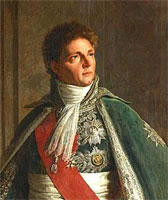
General Berthier
(1753–1815).
|
| |
In
a bizarre twist on the story of King Henry VIII and Catherine
of Aragon, Pope Pius VII legalized Maria's marriage
to the Prince of Wales.
Their
marriage violated 2 Acts of Parliament.
Maria
first appealed to Pope Pius VI, but he refused to get involved,
so French soldiers under general Berthier invaded Rome and
had him deposed!!
|
|
|
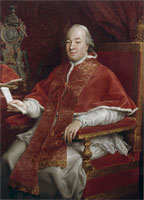
Pope Pius VI.
Pope from 1775 to 1799. |
A new more compliant
Pope was chosen by Napoleon. Soon after the new Pope was installed,
Prince George and Maria sent a priest to Rome named Fr. John Nassau,
who had an audience in Latin with the new Pope:
To do this Maria
needed some authority to confirm her view. Obviously she could turn
neither to the courts nor to Parliament. As a Catholic, however, she
did have a card up her sleeve. Like Catherine of Aragon she could
appeal to the Vatican for a decision. While she later said she would
have left England had the Pope declared her marriage void, she was
in 1799 probably fairly sure the Pope would acknowledge the validity
of her marriage from the Church's point of view. It was not so much
that she was a devout Catholic – how does one separate out devotion
from interest? – but that she had no other source available.
(Munson, Maria Fitzherbert, p. 294).
Obviously, the new
puppet Pope realized that he had to cooperate with his new
masters.
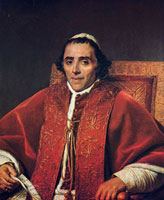
Pope Pius VII.
Pope from 1800 to 1823.
|
| |
The
new puppet Pope installed by Napoleon and the British Parliament
did recognize the marriage as legal; thus legitimizing her
firstborn, John Conroy, and her granddaughter Victoria.
Not
everything went as planned because the king was not dead
and the vast majority of the common people were totally
opposed to the secret Papal marriage.
|
|
|
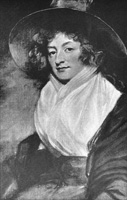
Maria Fitzherbert
circa 1800.
|
The
Papal Bull legitimizing the marriage finally reached London in November
1800:
The
marriage was found to be canonically valid, and Maria Fitzherbert
was therefore free to return to the Prince of Wales as his wife, provided
the Prince was suitably penitent, which he no doubt claimed to be.
John Nassau did not reach London until the following November, when
a papal bull outlining Rome's decision was handed to a grateful Maria,
who now knew she could live as the Prince's wife with an easy conscience,
regardless of public opinion.(Irvine, The King's Wife: George
IV and Mrs Fitzherbert, pp. 93-94).
Maria
was a "practicing Catholic" and if she became queen she would
be another Jezebel or Bloody Mary Tudor. Unlike Cardinal Campeggio at
the time of Henry VIII, Fr. Nassau arrived back in Britain with a Papal
Brief legalizing the marriage.
The
second attempt to murder the king happened in 1811
By
1811, Israel had been reestablished in the New World and the Louisiana
Purchase had extended her boundaries to the mighty Mississippi River.
Parliament
had given the green light to the invasion and occupation of New Orleans.
The Christian king would never have countenanced such perfidy and Machiavellian
double-dealing, so Parliament ordered his assassination by poison.
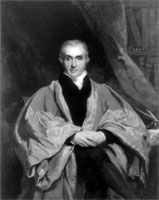
Dr. Matthew Baillie
(1761–1826). |
| |
With
the invasion of New Orleans imminent, Parliament ordered
the king's doctors to poison him.
The
"mad doctors" failed again to kill the king because
he was divinely protected.
They
only succeeded in having the 73-year-old king declared "insane." |
|
|
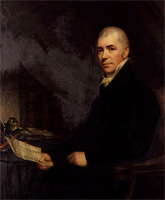
Sir Henry Halford
(1766–1844). |
This
time nothing was left to chance and the big battalions were brought
in:
A
day or so later the King became so difficult to control that Dr Samuel
Simmons, the mad-doctor, was summoned to Windsor. He went away again
when he was given to understand that he was not to be given sole charge
of the case; and thereafter the patient was left in the care of a
whole succession of doctors who were already at Windsor or soon to
go there–Sir Henry Halford, Matthew Baillie, Henry Reynolds,
David Dundas, Robert Battiscombe, William Heberden, and Robert and
John Willis. Also in attendance from time to time were John Meadows,
a former surgeon-apothecary at St Luke's Hospital, and a Mr Briand,
keeper of a madhouse at Kensington, who arrived with two formidable
assistants. (Hibbert, George III, p. 397).
Their
potent poison failed again but they did succeed in having the king declared
"insane." That was enough for Parliament to make the Prince
of Wales Regent.
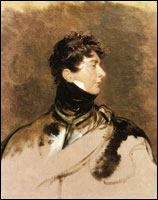
Portrait of the Prince of
Wales painted in 1814.
|
|
The
Prince of Wales was Regent during the momentous Battle
of New Orleans.
Had
that invasion succeeded, the king would have been strangled
by his doctors and the Prince of Wales would have become
king.
The
mask would come off and Great Britain would have a Papal
sovereign once again.
|
|
|
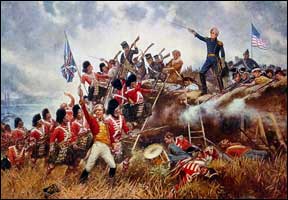
The Battle of New Orleans
on January 8, 1815. |
His
wife Maria Fitzherbert would have been another Jezebel and Bloody Mary
Tudor. Britannia owes a tremendous debt of gratitude to the heroic general
Jackson.
King
George received his great reward in Heaven in 1820
For
the last 9 years of his life, the king had to endure the indignity of
having his murderous son reign in his stead as Regent. Additionally,
he endured a whole lifetime of persecution because of his Christian
Faith.
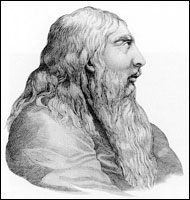
Engraving by Henry Meyer
of George III in later life.
|
|
Thanks
to the doctors, the king went blind and deaf toward the
end of his life.
A
new term was invented for his "malady" called
porphyria.
The
king did torment his doctors by staying alive until
1820. |
|
|
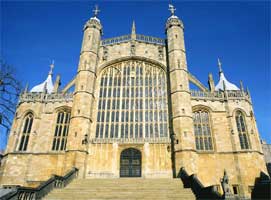
Burial place of King George at St.
George's Chapel, Windsor Castle. |
King
George went to meet his grateful Maker on January 29, 1820. The memory
of the just is blessed so the entire nation went into mourning. The
common people knew that the persecutions he endured were all religiously
motivated:
When
the King's death was announced, shops closed their doors all over
the country, and the whole nation, so it was said, went into mourning,
even the poor of London wearing some token of their sympathy. Over
30,000 people came down to Windsor for the funeral, which took place
in St George's Chapel on the night of 16 February. The procession
of black-clothed mourners, accompanied by heralds in their brightly
coloured tabards, walked by torchlight from the Castle to the Chapel
along a specially constructed platform draped in black cloth and lined
with soldiers. To the sound of muffled drums, trumpets, minute-guns
and the tolling of the death-bell, the mourners passed through the
south door of the Chapel as the choir sang the anthem 'I Know that
my Redeemer Liveth.' (Hibbert, George III, p. 409).
King
George was finally succeeded by the Prince of Wales. In 1795, George
married Caroline of Brunswick, but he HATED her, and they had only one
child–a girl named Princess Charlotte.
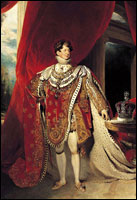
King George
IV (1762–1830).
King from 1820 to 1830.
|
| |
The
Prince of Wales finally succeeded to the throne in 1820.
Caroline
of Brunswick was his queen, but he did not consider her
his legal wife. The couple had only one child together,
a daughter named Charlotte.
Princess
Charlotte later married Leopold of Saxe-Coburg-Gotha but
she died in childbirth.
|
|
|
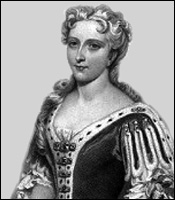
Queen Caroline (1768–1821). Queen from 1820 to 1821.
|
Nothing
could persuade the new King George to give up Maria Fitzherbert. Their
firstborn was John Conroy, and the couple had several more children
together; one of them, James Ord, was taken to the United States by
John Carroll, the first Papal bishop of the new United States. Another
daughter, Minny Seymour, was the center of a fierce custody battle between
the Seymours and Maria Fitzherbert.
When
King George IV went to meet his Maker, he was buried in Westminster
Abbey with a locket of Maria Fitzherbert around his neck.
King
William IV was the last lawful Hanoverian sovereign
Princess
Charlotte would later marry Leopold of Saxe-Coburg-Gotha but she died
in childbirth. The next and last lawful Hanoverian king to
reign after the death of King George IV was King William IV.
Adelaide
married William in a double wedding with William's brother, Prince Edward,
Duke of Kent, and his bride Victoria, Dowager Princess of Leiningen,
on 11 July 1818, at Kew Palace in Surrey, England. They had only met
for the first time about a week earlier, on 4 July at Grillon's Hotel
in Bond Street. Neither William nor Adelaide had been married before,
and William was twenty-seven years her senior.
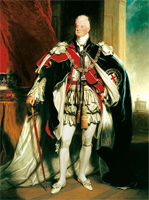
King William IV (1765–1837).
King from 1830 to 1837.
|
| |
King
William IV was the 3rd son of King George III.
William
married Adelaide in a double wedding with his brother, Prince
Edward, Duke of Kent, and Victorie–future mother of
Queen Victoria.
Adelaide
in Australia is named after her. |
|
|
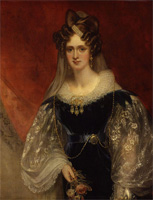 Queen Adelaide
(1792–1848).
Queen Adelaide
(1792–1848).
Queen from 1830 to 1837. |
With
the death of King William in 1837, the lawful Hanoverian dynasty,
that had played such a momentous role in world history, came to an end.
Queen
Victoria was a Hanoverian on her father's side but the Prince of Wales-Fitzherbert
marriage was illegal. Because of the defeat at New Orleans, the British
Papal Parliament could not achieve its fondest wish and place a Papal
sovereign openly on the throne.
Vital
Links
References
Ambrose,
Tom. Godfather to the Revolution: The Life of Philippe Égalité
duc D'Orleans. Peter Owen Publishes, London, 2008.
Brooke,
John. King George III. McGraw-Hill Book Company. New York,
1972.
Brodsky,
Alyn. Benjamin Rush: Patriot and Physician. St. Martin's Press,
New York, 2004.
Buell, Augustus C. The Memoirs of Charles H. Cramp. J.B. Lippincott Compnay, Philadelphia & London, 1906.
Carlyle, Thomas.
The French Revolution: A History. Modern Library, New York, 1934.
(First published in 1834).
David, James Corbett. Dunmore's New World: The Extraordinary Life of a Royal Governor in Revolutionary America. University of Virginia Press, 2016.
Hibbert,
Christopher. George III: A Personal History. Basic Books, New
York, 1998.
Black, Jeremy.
George III: America's Last King. Yale University Press, New Haven
& London, 2006.
Hibbert,
Christopher. George IV: The Rebel Who Would Be King. PalgraveMacmillan,
New York, 2007.
Hadlow,
Janice. A Royal Experiment: The Private Life of King George III.
Henry Holt & Co., New York, 2014.
Hudson, Katherine.
A Royal Conflict: Sir John Conroy and the Young Victoria. Hodder
& Stoughton, London, 1994.
Irvine, Valerie.
The King's Wife: George VI and Mrs Fitzherbert. Hambledon and
London, London, UK. 2005.
Munson,
James. Maria Fitzherbert: The Secret Wife of George IV. Carroll
& Graf Publishers, New York, 2001.
McCullough, David.
John Adams. Simon & Schuster, New York & London, 2001.
Powell, J.H. Bring
Out Your Dead: The Great Plague of Yellow Fever in Philadelphia in 1793.
Time, Inc., New York, 1965.
Preston, Diana. The Road to Culloden Moor: Bonnie Prince Charlie and the '45 Rebellion. Constable, London, 1996.
Waterman, Joseph. With Sword and Lancet: The Life of General Hugh Mercer. Garrett & Massie, Richmond, Virginia, 1941.
Copyright
© 2020 by Patrick Scrivener
Back
to Main Menu




































